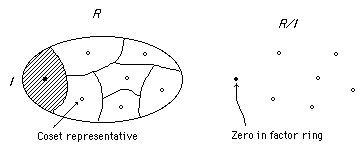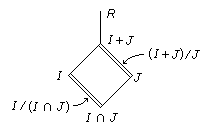
| Previous page (Ring homomorphisms and isomorphisms ) | Contents | Next page (Finite fields) |
We parallel the development of factor groups in Group theory.
Definition
If I is an ideal of a ring R and a ∈ R then a coset of I is a set of the form a + I = {a + s | s I }.
The set of all cosets is denoted by R/I.
Remarks
Theorem
If I is an ideal of a ring R, the set R/I is a ring under the operations
(a + I) + (b + I) = (a + b) + I and (a + I) . (b + I) = (ab) + I.
Proof
We need to check that the operations are "well-defined". That is if a1 and a2 are representatives of the same coset and b1 and b2 represent the same coset then a1 + b1 and a2 + b2 represent the same coset and so do a1b1 and a2b2.
We have a1 - a2 I and b1 - b2 I and so adding these shows that (a1 + b1) - (a2 + b2) ∈ I and so these do represent the same coset.
Similarly, for the product, observe that a1b1 - a2b2 = (a1 - a2)b1 + a2(b1 - b2) and the result follows from the properties of the ideal.
Once you know that the operations are well-defined the ring axioms follow easily. 
Note that the zero of the factor ring is the coset 0 + I or the ideal I itself.
Remarks

Examples
Then every coset has a representative of the form (a + bx) + I since if we choose a coset representative (say) x3 then we have x3 = -x + (x2 + 1)x - x + I and so -x will do for a representative instead. You should see that by thinking of x2 + 1 as 0 one can use the "rule" x2 = -1 to get rid of all higher powers.
So we get a ring in which we can add and multiply things like a + bx using the rule x2 = -1 to do multiplication.
If you replace the indeterminate x by i you will see that this is the complex numbers.
That is: R[x]/ < x2+ 1 >
Notice that the reason that this happened was that the polynomial x2 + 1 factorises in Z5[x] into a product of factors of lower degree. (You could see it had linear factors since the polynomial has roots in 5.)
We saw in the last section that the kernel of a ring homomorphism is an ideal and the image is a subgroup. In view of the corresponding result for groups it will come as no surprise that we have
The Isomorphism Theorem for Rings
If f :R→ S is a ring homomorphism the factor ring R/ker(f) is isomorphic to im(f).
Proof
Define the map θ: R/ker(f)→ im(f) by θ(a + ker(f)) = f(a).
Then the proof is exactly as in the group theory case except you also need to check that this map respects the ring multiplication as well as addition. 
Remarks
The above result is sometimes called the First Isomorphism Theorem for Rings. Here are some others.
The Second Isomorphism Theorem for Rings
Let I and J be ideals of a ring R. Then I + J and I ∩ J are also ideals and the factor rings (I + J)/J and I/(I ∩ J) are isomorphic.
Proof
Here is a picture showing the inclusions. The double lines represent the two factor rings.
To prove the result, Define θ : I→ (I + J)/J by i ↦ i + J.
Since every coset in (I + J)/J has a representative of this form θ is onto.
If i ∈ ker(θ) then i + J = J and so i ∈ J and hence is in I ⊆ J.
The result now follows from the First Isomorphism Theorem.
Remark
In fact one only needs I to be a subring of R for this theorem to hold. One does need J to be an ideal.
Example
Let I = < m > and J = < n > be ideals of Z. Then (See Exercises 4 Qu 1) I + J = < gcd(m, n) > and I ∩ J = < lcm(m, n) > .
Then from this theorem one deduces that < gcd(m, n) > / < n >  < n > / < lcm(m, n) > and from this you may deduce that n/gcd(m, n) = lcm(m, n)/m or that gcd(m, n) × lcm(m, n) = mn (See Exercises 3 Qu 6).
< n > / < lcm(m, n) > and from this you may deduce that n/gcd(m, n) = lcm(m, n)/m or that gcd(m, n) × lcm(m, n) = mn (See Exercises 3 Qu 6).
The Third Isomorphism Theorem for Rings
Let I and J be ideals of a ring R with I ⊆ J. Then J/I is an ideal of R/I and (R/I)/(J/I)  R/J
R/J
Proof
It is easy to verify that J/I is an ideal of R/I.
Define a map θ : R/I→ R/J by a + I ↦ a + J for any coset a + I of I in R. This is clearly onto.
An element a + I is in the kernel of θ if a + I = J which (since I ⊆ J) will only happen if a ∈ J. Thus ker(θ) = J/I ⊆ R/I and the result follows from the the First Isomorphism Theorem.
| Previous page (Ring homomorphisms and isomorphisms ) | Contents | Next page (Finite fields) |